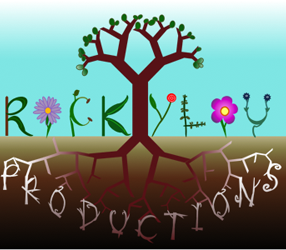[soundcloud url=”http://api.soundcloud.com/tracks/95490369″ params=”” width=” 100%” height=”166″ iframe=”true” /]
[soundcloud url=”https://api.soundcloud.com/tracks/96080634″ width=”100%” height=”166″ iframe=”true” /]
 Here’s a picture of what went on technically behind the scenes to create the LoDown Episode 17 and the LoDown Episode 23 podcasts.
Here’s a picture of what went on technically behind the scenes to create the LoDown Episode 17 and the LoDown Episode 23 podcasts.
1. Preparation
My daughter, Amber, and I talked about what we might like to do and what format to use. The interview format appealed to both of us. I jotted down some concepts and themes that I wanted to include in the interview and posted them to Google Docs. This way Amber and Scott could see what I was thinking and respond in an asynchronous way, when their schedules allowed it. The document was continually updated when any of us had additional ideas or comments.
We eventually came up with 8 interview questions which included notes with talking points and examples that we wanted to include in our responses. Putting the questions in an order that made sense and flowed well took some thinking and working. We weren’t creating a script, but we needed to know where we were going. We didn’t want this to be a rambling flow of consciousness thing. Amber also identified which sound effects she wanted to use, and where they could be found in the Obruni podcasts.
Our time together to record the interview was limited, and I needed to have everything finished and sent to Scott soon. So we needed to hit the ground running.
- I had the studio set-up with chairs and two mics. (had to go out and buy a 2nd pop filter)
- I re-familiarized myself with my audio mixer. As much as I could on my own, I balanced the sound levels for the two microphones. This gave me a chance to practice speaking, recording, and listening to what I sounded like. I noticed I was speaking too fast and needed to slow it down significantly. That took some practice. (Scott suggested I smile and relax.) Recognizing this before we started recording together, meant I could warn Amber and she could help me to remember to slow down.
- I created a new file in GarageBand and gathered all of the zingers, bumpers, and sound effects that would be needed for the completed podcast. Fortunately, I didn’t need to go hunting on the internet or create any new sounds. I only had to locate them on my computer from past projects and place them in my new file. I optimized volume levels and aligned the timing of the intro & outro bumpers, and also went ahead and recorded my solo spoken intro and outro. (I’d already used up 4min of air time before the interview even started!) It took a couple of hours to find everything and set it up in GarageBand, so that “all I had to do” was to drop in the interview tracks.
2. The Actual Interview
When Amber arrived at 6pm we still had work to do to get the interview questions and talking points to a place we were both comfortable. By 7pm we were almost ready to record. The sound check with both of us speaking went surprisingly smooth. The pre-work I’d done earlier paid off. We weren’t sure how this was going to work, but we were hoping we could do it in one take to keep the energy alive and spontaneous.
One take was all it took – except for when the dog came into the studio, whining, and we had to stop recording to take her back upstairs. Not only did we have to redo a quick section, but I started talking too fast, and we had to wait until I could relax and settle myself back down again.
When we finished the interview we had 30 minutes of material. Ooops! How’d that happen? Now what? It turned out that the way we had structured the interview questions there was a logical mid-point where we could split it into two parts. Fortunately they were both about 15 minutes long. We decided we had accidentally made two podcasts, and I’d only work up one of them now. [Link to 2nd half] We spot checked the quality of the recording instead of listening to the whole thing like we would usually do. Amber needed to get home. We were happy with what we heard and Amber was out the door by 8:30pm.
3. Post-Production

Using only the first half of the interview, I went to work editing (or proof reading) the sound file to take out mistakes and dialogue that weren’t really needed to tell the story. I also had to add in the sound effects. I know my way around GarageBand, and have produced several of the Obruni podcasts, so I was able to complete this phase in under 3 hours. This wouldn’t have been possible if I’d been working with the entire 30 minutes. You have to listen to it, and the whole thing mind you, a couple of times through to make sure you don’t miss something. Even though I’m thorough and pay attention, I continue to catch mistakes or spots I’d like to clean up a bit more when I turn it into an mp3. The third time was a charm.
4. Final Steps
- Upload the file, which took a few failed attempts on SoundCloud before I just gave up and uploaded it VERY simply to google docs.
- Write up the blog post for the LoDown with hyperlinks activated
- Write my own blog entry on my process. (I worked on this alone for about 90 min.)
UPDATE Oct 7, 2013:
You can listen to all of the Obruni Podcast episodes.


[…] trying to do this daily for 35 days straight. Making one of these is a lot more work with the behind the scenes preparation and post-production that you can’t appreciate until you’ve made one yourself. And keeping the time of the […]
You should do a a journal entry on your experience with this class for the rockylouproductions site and provide both a blog and front page link this ds106 blog and to the radio interview content.
[…] own podcasts, provided us with almost 30 minutes of airtime. That was too long for the editing, post-production phase with the time constraints I was under. And I sense our listeners aren’t so keen on sitting […]
[…] trying to do this daily for 35 days straight. Making one of these is a lot more work with the behind the scenes preparation and post-production that you can’t appreciate until you’ve made one yourself. And keeping the time of the episode […]